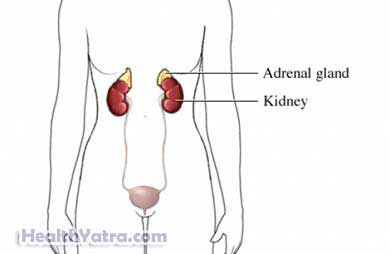Definition
Pheochromocytoma is a tumor. It is made up of special adrenal gland cells. These cells secrete hormones such as epinephrine and norepinephrine. These hormones help to regulate the heart rate and blood pressure. The cells may secrete excessive amounts of the hormones. This results in periods of:
- Very high blood pressure
- Rapid heart beat or palpitations
- Excess sweating
- Severe headaches
Most of these tumors are benign (noncancerous). About 10% are malignant (cancerous). Most of the tumors grow on the adrenal glands. The glands are on top of the kidneys. About 10%-20% the tumors occur elsewhere in the body.

Causes
The cause is not yet known. Scientists suspect a genetic link.
Risk Factors
Factors associated with pheochromocytoma include:
- A family history of pheochromocytoma, tumors in other glands of the body, or other hormonal disorders
- Genetic diseases including:
- Von Hippel-Lindau disease
- Multiple endocrine neoplasia, type 2
- Neurofibromatosis type 1
- Paraganglioma syndromes
Symptoms
Up to 50% of patients have no symptoms. This tumor is found during the investigation of some other unrelated illness.
Symptoms may occur many times during the day. They can also occur as infrequently as once every few months. Symptoms may be brought on by pressure on the tumor (during a massage), medicines (such as certain anesthetics and beta-blockers), or intense emotion. Symptoms can include:
- Severe headaches
- Excessive sweating
- Fast heart rate ( tachycardia)
- Sensation of a panic attack
- Vision changes (blurred vision)
- Nausea, vomiting, constipation
- Pounding heart beat (palpitations)
- Chest pain
- Involuntary trembling (tremor)
- Pain in the lower chest or upper abdomen
- Warmth, flushing
- Increased appetite
- Weight loss
- Insomnia
- High blood pressure (either sporadic or constant)
- Tingling, burning, or numbness in the legs and feet
- Shortness of breath
- Muscle weakness
- Anxiety
- Unable to cope with high temperature
- Aggressive or unusual behavior
Diagnosis
Your doctor will take a medical history. A physical exam will be done.
Your doctor may need to test your bodily fluids. This can be done with:
- 24-hour urine testing
- Blood testing
- Clonidine suppression test
Your doctor may need images of your body structures. This can be done with:
- CT scan
- Ultrasound
- MRI scan
- MIBG scintiscan (or adrenal medullary imaging)
- Fluorodopamine PET scan
Treatment
Laparoscopic Adrenalectomy
If the tumor is benign, it is removed. This procedure uses small incisions and special instruments.
Sometimes, the adrenal glands are removed as a part of this process.
Medications
Prior to surgery, high blood pressure will need to be brought under control using blood pressure lowering medicines.
Chemotherapy
This may be used if the tumor is cancerous and has spread outside of the adrenal glands.
Radiation may also be used to help destroy the tumors if they have spread
Prevention
There are no known prevention methods.
